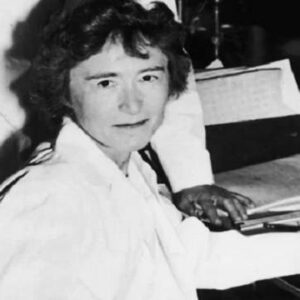Theresa Gerty Radnitz Cori is the first American woman to share the Nobel Prize in Physiology or Medicine with her husband and fellow researcher Carl F. Cori. She was educated at home until the age of 10, after which she was admitted to the Lyceum for females. She attended Tetschen Realgymnasium after passing the university entrance exam and graduating from high school. She enrolled at the Medical School at the University of Prague and earned her medical degree. Then she spent two years at the Carolinen Children’s Hospital before relocating to the United States with her spouse Carl. After working together in Buffalo, she joined him at St. Loius as a Research Associate. Thereafter, she was promoted to Professor of Biochemistry. They were discouraged from working together at Roswell, but it did not stop them from pursuing scientific endeavors, as seen by the fifty articles they published together there. As students, the Coris collaborated on research projects due to their shared interest in preclinical sciences. They investigated how sugar and glucose are metabolized. The Cori cycle, which explained the transfer of energy inside the body, was the theory for which they were awarded the Nobel Prize.
Youth and Early Life
Gerty was born in Prague on August 15, 1896, as a Jew. She was the eldest of Otto and Martha Raditz’s children. Her father held a position in management at one of the sugar factories.
She was homeschooled until the age of ten, then in 1906, she attended a Lyceum for girls.
In 1912, she graduated from high school and studied for the university entrance examination. Two years later, she took the exam at the “Deutschen Realgymnasium” and passed.
At the age of sixteen, Gerty chose to pursue a degree in medicine. Uncle, a professor of medicine at the “University of Prague,” influenced the choice.
Gerty was admitted to the ‘Medical School’ at the ‘University of Prague’, and in 1920 she earned her medical degree.
During her time as a medical student, she was acquainted to a classmate named Carl Ferdinand Cori who shared her passions for mountain climbing, skiing, and gardening. They collaborated and published the outcomes of their initial research endeavor.
Gerty Cori’s Career
After graduation, Gerty and Carl wed and were invited to work in various Vienna clinics. While working in Vienna, they realized the impending war’s ramifications and began seeking opportunities abroad.
Gerty worked for two years at the ‘Caroline Children’s Hospital’ before moving to the United States with her husband Carl.
Carl was offered a position at the ‘State Institute for the Study of Malignant Diseases’ and the family moved to Buffalo in 1922. Gerty was initially offered entry-level work as an assistant pathologist. Later, the institute became known as the Roswell Park Memorial Institute.
During their time in Roswell, they were discouraged from collaborating, but the fact that they authored fifty research papers together in Roswell is evidence of their scientific success.
In 1929, the scientific duo developed the idea that eventually led to their nomination for the Nobel Prize.
Carl became Chairman of the Department of Pharmacology at the ‘Washington University School of Medicine in 1931. Gerty was offered the post of research associate, which she held for sixteen years as her husband advanced through the ranks of the university.
Gerty was named Associate Professor of Research Biological Chemistry in 1943.
In 1946, when Carl gained the position of the head in the new biochemistry department, Gerty was initially granted the title of Professor, a position that was later solidified after she won the Nobel Prize.
They were awarded the Nobel Prize in 1947, and two months later, Gerty was promoted to professor of biological chemistry. The Coris family got the prestigious award for their discovery of the enzymes that aid in the conversion of glycogen to sugar as well as the reverse process.
Her Major work
The most well-known of her works is the ‘theory of Cori cycle,’ which described the body’s glucose metabolism. According to the hypothesis, the muscles convert a portion of the carbs, specifically glycogen, into lactic acid, which is subsequently transformed back into glycogen by the liver so that it can be utilized by the muscles.
Awards & Achievements
Theresa was awarded the Garvan Medal, an honor granted to female chemists by the American Chemical Society.
She was invited to join the “National Academy of Sciences.”
Gerty and her respected husband have a star on the St. Louis Walk of Fame.
The ‘American Chemical Society’ honored the pair with the ‘Midwest Award’ in 1946. They got the “Squibb Award in Endocrinology” the following year.
Gerty got the “Sugar Research Prize” in 1950 and the “Borden Award” the following year.
In 1952, after receiving the Nobel Prize, President Harry Truman appointed her to the ‘National Science Board’ of the ‘National Sciences Foundation’
Personal History and Legacy
Carl and Gerty, who were classmates, were married in 1920, shortly after graduation.
Upon the end of the war, they emigrated to the United States and obtained citizenship in 1928. Carl Thomas, their only son, was born eight years later.
In 1947, Gerty was diagnosed with Myelofibrosis, which is an uncommon bone marrow disorder. Despite the severe agony caused by her illness, she maintained her investigation.
On October 26, 1957, she passed away due to renal insufficiency. The renowned journalist Edward R. Murrow documented her career as a researcher, her commitment to science, and her professionalism and intellectual honesty.
Cori crater on the moon was named after her.
Estimated Net Worth
Unknown.


